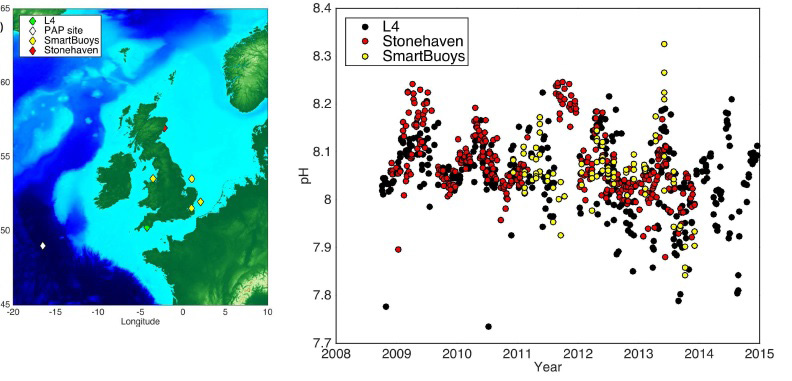pH and ocean acidification
Since the UK Initial Assessment (HM Government, 2012), new datasets have increased the understanding of carbon dioxide exchanges and ocean acidification in UK waters. The evidence for 2011-2015 shows that the trends in UK waters are consistent with the global results, driven by atmospheric carbon dioxide, although strong temporal and spatial variability is observed.
Background
Ocean acidification is the large-scale, long-term decrease in pH (in-crease in hydrogen ion concentration) occurring as a consequence of increasing carbon dioxide (CO2) in the atmosphere. When CO2 dissolves in seawater, it forms carbonic acid, which then dissociates to release carbonate and hydrogen ions. Associated chemical changes include increased concentrations of bicarbonate ions, but decreased levels of carbonate ions, which lower the saturation state of calcium carbonate, used by many marine organisms for their shells and other external coverings. Low carbonate saturation states can cause the dissolution of these structures, particularly in deeper and/or colder water, where dissolved CO2 levels are naturally higher (and pH lower). Data on acidification for UK waters was limited in 2012 and therefore, the 2012 UK Initial Assessment (HM Government, 2012) concluded that:
“because there are currently no baseline measurement of pH against which changes in UK waters can be judged, it will be some time before we can make accurate judgements about the rate of acidification relative to natural annual and interannual cycles of pH. We also need a better understanding of the physical, chemical and biological processes controlling the ocean’s ability to absorb CO2”.
New datasets are available, including data from (the UK Ocean Acidification Research Programme), the PLACID project (Placing Ocean Acidification in a Wider Fisheries Context) and other sources, thus making it possible to greatly improve the characterisation of CO2 and ocean acidification in UK waters between 2011 and 2015.
Climate Projections
Model results from a coupled physical-ecosystem model (NEMO-ERSEM) forced with data from the Intergovernmental Panel on Climate Change (IPCC) Representative Concentration Pathway (RCP) 8.5 scenario show an overall decrease in pH and aragonite saturation state over the 21st Century. The trend for pH being -0.0036±0.00034 pH units per year for the Greater North Sea and -0.0033±0.00019 for the Celtic Seas. These are notably similar to the trend calculated from the ICES pH data over the last 3 decades. Aragonite under-saturation is likely to occur occasionally (especially in winter months) in some areas from 2030 on and accelerated from 2080 on.
Results
To calculate long term trends in pH a dataset of >25 years is required. The ICES dataset over the period 1984-2014 provides the best available information to determine the long-term trend in UK/European waters, but only the Greater North Sea and English Channel are adequately sampled. In these areas the trend based on annual means was calculated in the first 20 m of the water column, resulting in a trend of -0.0035 ± 0.0014 pH units per year (see Figure 1).

Figure 1. Map of the ICES pH data with OSPAR boundaries shown. Right: Mean annual pH within the top 20 m for the Greater North Sea from 1984-2014, with the trend and standard deviation shown.
The fixed-point time series in UK waters are not long enough to calculate trends, but show that pH measurements present a clear seasonality and strong interannual variability (see Figure 2), thus proving that consistent long-term measurements are required to calculate trends accurately.

Figure 2. pH calculated from dissolved inorganic carbon and total alkalinity measurements collected at fixed-point observatories. The locations are shown on the map in the left panel.
With respect to the seasonality, pH is higher in spring and decreases in autumn. This variability is related to biological processes rather than to advection. In spring, CO2 is consumed through photosynthesis by phytoplankton (increasing pH) and is produced in autumn through respiration by zooplankton and degradation of organic matter by bacteria (decreasing pH). Mixing with deep waters richer in CO2 also plays a role in autumn/winter. This pattern is consistent in all UK waters, although the observations seem to confirm that, especially during the autumn months, the concentration of CO2 is higher in the Southern North Sea, where the input from rivers (watershed runoff of high carbon waters and organic matter inputs) contributes to the overall CO2 increase. Indeed, measurements of CO2 fugacity show that this area around the Southern North Sea is the only area of UK waters that acts as a source of CO2, but only in the period July-September, corresponding to the high riverine run-off.
Focusing on the water column, a vertical gradient in pH exists especially in the deeper areas that experience strong vertical stratification during summer (Northern North Sea and Celtic Sea), with pH lower at depth.
At the sea floor, the range of pH values at which the organisms are exposed/adapted is wide in the North Sea (approximately 7.4-8). Strong vertical gradients are observed in the first cm of the sediment, with pH decreasing between 0.5-1 unit.
Conclusions
The evidence from 2011 - 2015 is fully consistent with the global trend for ocean acidification, as driven by atmospheric CO2. Data show a strong seasonal and interannual variability, as well as spatial variability (also vertically) in UK waters.
Knowledge gaps
There are limited datasets available to contribute to the assessment of local conditions and long-term changes. New sensors and platforms (like gliders and profiling floats) could be considered to increase the cost-effectiveness and spatial coverage of UK ocean acidification measurements.
Most ocean acidification measurements are near surface leading to a knowledge gap in understanding change in seasonally stratified areas and at the sea-bed in general.
Additional datasets are required to understand variability and its causes at a European scale. The implications of emission scenarios consistent with the full and partial implementation of the Paris Agreement are not yet fully known.
References
HM Government (2012) ‘Marine Strategy Part One: UK Initial Assessment and Good Environmental Status’ (viewed on 5 July 2018)
UK Ocean Acidification Programme Synthesis Report:
Ostle C, Williamson P, Artioli Y, Bakker DCE, Birchenough S, Davis CE, Dye S, Edwards M, Findlay HS, Greenwood N, Hartman S, Humphreys MP, Jickells T, Johnson M, Landschützer P, Parker R, Pearce D, Pinnegar J, Robinson C, Schuster U, Silburn B, Thomas R, Wakelin S, Walsham P, Watson AJ (2016) ‘Carbon dioxide and ocean acidification observations in UK waters: Synthesis report with a focus on 2010- 2015’ doi: 10.13140/RG.2.1.4819.4164 (viewed on 14 January 2019)
Acknowledgements
Assessment Metadata
Please contact marinestrategy@defra.gov.uk for metadata information
